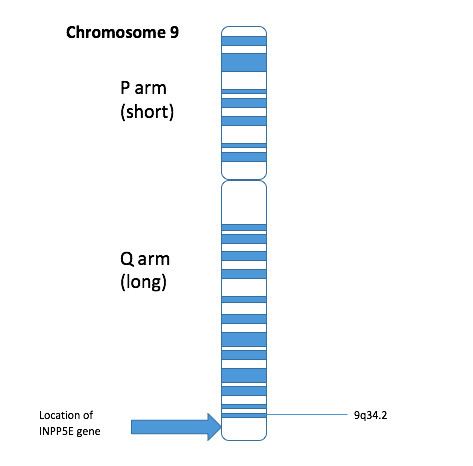OMIM 610156 | ||
 | ||
MORM Syndrome
MORM syndrome is an autosomal recessive congenital disorder This means that the disorder is present from birth and is likely the result of both healthy parents passing on a defective gene, associated with MORM syndrome, to their offspring. The disorder is not dependent on sex of the offspring, both male and female offspring are equally likely to inherit the disorder. The term MORM is used to describe the characteristics associated with the disorder which include mental retardation, truncal obesity, retinal dystrophy, and micropenis". The disorder shares similar characteristics with Bardet-Biedl syndrome and Cohen syndrome, both of which are autosomal recessive genetic disorders. MORM syndrome can be distinguished from the above disorders because symptoms appear at a young age.
Contents
The syndrome is caused by a mutation in the INPP5E gene which can be located on chromosome 9 in humans. Further mapping resulted in the identification of a MORM syndrome locus on chromosome 9q34.3 between the genetic markers D9S158 and D9S905.
Characteristics
For individuals with MORM syndrome, symptoms do not appear until about one year into the child’s life span. From conception to birth, individuals with MORM syndrome appear asymptotic with no abnormal characteristics. Vision is negatively affected within the first year of life, particularly night vision. Individuals with MORM syndrome experience decreased visual acuity meaning their ability to see distinct sharp lines decreases. Vision quality continues to deteriorate until age three. Any further reduction in vision acuity is not observed until the individual is between the ages thirty to forty. Delayed sentence processing and intellectual disability is associated with individuals with MORM syndrome, primarily observed at age four. Individuals continue to develop and grow until they are five to twelve years old. During this age bracket, truncal obesity can develop. Truncal obesity is a term used to describe the build up of fat around ones trunk or torso as opposed to the persons extremities. Males enter puberty at around age twelve and develop normally except for their sex organ. The males penis will remain at the prepubescent size resulting in a micropenis. The life span of individuals with MORM syndrome is unclear as well as the fertility of these individuals.
Diagnosis
MORM syndrome is a genetic disorder obtained through inheritance. The main method for testing individuals showing symptoms of MORM syndrome is sequence analysis of the entire coding region. When performing a sequence analysis of the entire coding region the gene INNP5E is targeted. Sequence analysis is the biotechnological process in which the structure and sequence of DNA, RNA, or protein sequence is determined through the use of technology. The sequence can then be analyzed to determine mutations or abnormalities in that particular region. When testing for MORM syndrome, sequence analysis of the region of the genome which contains the gene INPP5E is targeted and examined to look for mutations.
Genetic Mapping
MORM syndrome is associated with the gene INPP5E. INPP5E is a gene who's function is not well understood. It is hypothesized to play a role in primary cilia stability. A homozygous mutation in the INPP5E gene, on chromosome 9q34, is the cause for MORM syndrome. The mutation causes a homozygous transition in the last exon of the INPP5E gene. This transition results in the DNA bases changing from a cytosine residue to a thymine residue. The resulting protein will then have an altered amino acid sequence. In unaffected individuals this specific codon (region of DNA bases) is supposed to code for the amino acid glutamine. In cases of MORM syndrome this codon codes for a termination sequence, which prematurely stops the production of the protein. In unaffected individuals the protein is evenly disbursed throughout the ciliia axoneme which allows for the cilia to be stable. Cilia are antenna like structures which protrude from the extracellular surface of the cell. The cilia allows for extracellular signalling/communication between cells and their environment. When the INPP5E gene is mutated, the protein is damaged and is unable to spread out along the cilia axoneme and is unable to interact with other stabilizing proteins. This results is MORM syndrome individuals being unable to stabilize their cilia axoneme. It is still not well understood the exact mechanism as to how the mutation in the INNP5E gene causes cilia instability.
